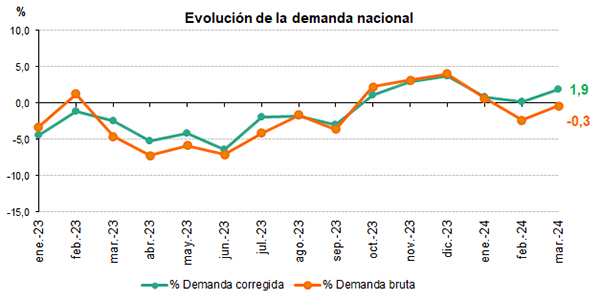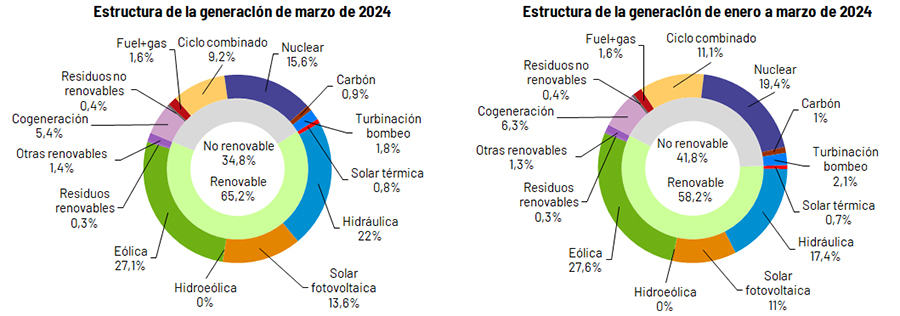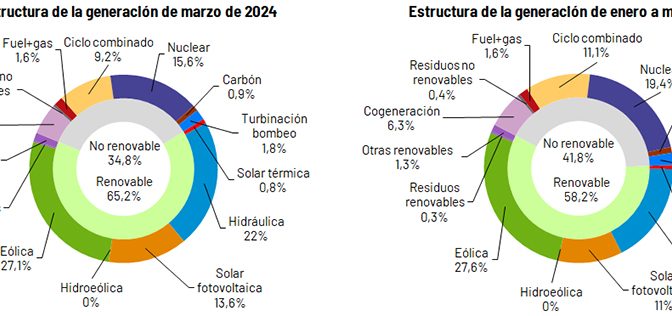The demand for electrical energy in Spain increases by 1.9% in March. Renewables reach a record monthly production (14,591 GWh) and also coverage in the mix (65.2%). Generation without emissions accounts for 82.2% of the total and reaches its highest share since records began. For the sixth consecutive month, wind energy continues to be the generation leader in Spain in March with a share of 27.1% of the total.
National electricity demand experienced an increase of 1.9% in March compared to the same month of the previous year, once the effects of temperature and work hours were discounted. In gross terms, a demand of 20,413 GWh is estimated, 0.3% lower than that of March 2023.

Evolution of monthly demand in Spain
In the first quarter of 2024, Spain has registered a demand of 62,484 GWh, 0.6% less than in the same period of 2023.
This month, renewables have reached their highest monthly contribution since records began, with 14,591 GWh, which represented 65.2% of the total mix, also a maximum. Production with renewables during this month of March has experienced an increase of 15.6% compared to the same month of the previous year.
According to provisional data available today, wind power, which has generated 27.1% of the total, has been the leading technology for the sixth consecutive month, with a production of 6,061 GWh. Hydraulic is next with a production of 4,937 GWh, the highest amount recorded since May 2016. In March, hydraulic contribution accounted for 22% of the total in Spain. For its part, in third position among renewable technologies, solar photovoltaics recorded 3,047 GWh in March and obtained a share of 13.6%.
All in all, emissions-free production has reached its best record this month, generating 82.2% of the total in Spain.

Generation structure in March and in 2024
Peninsular demand increases 1.6%
At the peninsular level and once the effects of work and temperature are taken into account, demand has been 1.6% higher than in March 2023. In gross terms, demand this month has been 19,209 GWh, 0. 6% lower than the same month of the previous year.
In the first three months of the year, peninsular demand has been 58,935 GWh, 0.8% lower than that registered in 2023.
The set of peninsular renewables generated 67.6% of the total in March, according to the provisional data available today, which shows a production of 14,411 GWh, 16.1% more than in the same month of the previous year. For their part, emission-free technologies contributed 85.7% of the total.
The peninsular generation structure in March is also led by wind power, which has been responsible for 28% of the total by producing 5,969 GWh during this month.
The electrical system in the Balearic Islands and Canary Islands
In the Balearic Islands, electricity demand in March was 7.4% higher than in the same month of 2023 once the effects of work hours and temperatures are taken into account. Thus, gross demand is estimated at 433,166 MWh, 4.5% more than in March of the previous year. In the accumulated amount of the first quarter of 2024, the Balearic gross demand is estimated at 1,284,644 MWh, 1% less than in the same period of 2023.
In terms of generation, the combined cycle, with 68.7% of the energy produced in the Balearic Islands, was the islands’ first source this month. For its part, renewable energy without CO2 equivalent emissions generated in the Balearic community represented 17.6% of the total, the largest share recorded in the archipelago. Balearic renewable production grew by 23.8% in March compared to the same month of the previous year, reaching 56,596 MWh.
Furthermore, the submarine link between the Peninsula and Mallorca contributed during this month to covering 25.6% of the Balearic electricity demand.
For its part, in the Canary archipelago, the demand for electrical energy grew by 4.9% compared to the same month in 2023, taking into account the effects of work schedules and temperatures. In gross terms, demand was 737,266 MWh, 3.6% more. In the first three months of 2024, Canarian demand is estimated at 2,169,079 MWh, 4.2% more than in the same period of 2023.
Regarding electricity generation in the Canary Islands, the combined cycle, with 43.8% of the total, was also the first source in March. Renewables and emission-free technologies reached a share of 16.8% of production, with the wind contribution being 12.4%.


